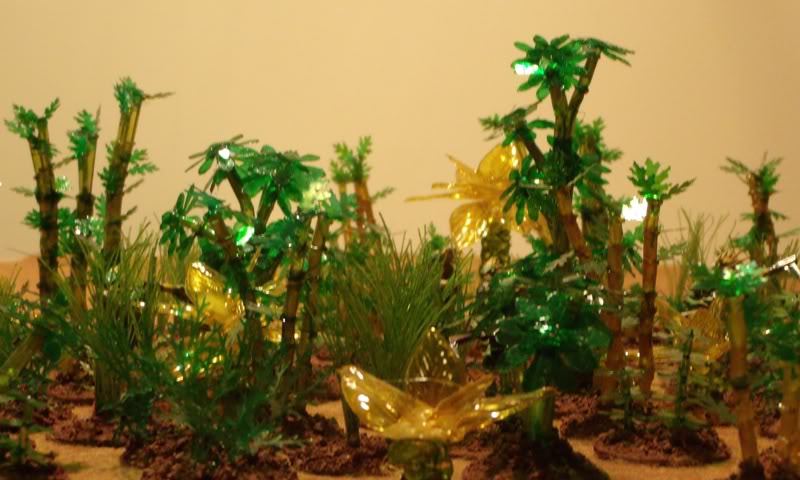
The Plastic Jungle is for those of you that want a decidedly alien looking table. Your pieces don’t need to be clear or translucent, but that was the path we decided to travel. These pieces are pretty easy to make, and best of all it is cheap! If you’re tired of all the tables that look like Earth or Mars, we’ve got you covered.
Deep in the back of your pantry, you have left over plastic utensils from that family reunion you hosted last night. What’s that? You see a bunch just sitting in the trash too? Well, go dig them out and wash them off, because we’re about to make a bizarre alien jungle, and those eating utensils are our first stop . The process is a bit more than just basing and painting them, but when we’re done, you’ll be playing on an alien surface that no one could guess was made of your old spoons, forks, and knives.

So how do we make a spoon look like anything other than a spoon? Just apply a little heat. Our goal is to make the utensils soft and malleable, so applying the right amount of heat is important. Depending on your method of heating, controlling the time and temperature may be very easy, or very hard. If you only want to make an few pieces, you can use something as simple as a candle. Handling large amounts is easier to do with an oven. If you’re just starting out, I suggest doing a few test by candle before trying to make a large batch. Keep in mind that every stove and every utensil brand is a bit different, so you may have to play around with them before you get it perfect.
Before you start cooking, I want to point out that we are NOT trying to melt the plastic. If you end up with a puddle, you’ve gone to far. In fact, you may have release some gasses you don’t want to breath. I wouldn’t suggest going that far without some proper ventilation. We ARE trying to get the plastic soft. Depending on your end goal, that can mean different things. In order to hit those sweet spots, there are about three stages you should look for:
- The utensil has shrunk a bit, but not too much. If you took it out now, it would be soft and easy to work with. You only have a short window to do your work though, because once they cool down, they become brittle again.
- The utensil has shrunk a lot. This can lead to some neat effects, but you won’t find much consistency.
- The utensil is starting to get air bubbles. Like when it shrank, this effect can add an interesting new look, but it is still inconsistent. You’ll need to be careful at this stage; wait too long and it will melt on you.

Now that you know what we are aiming for, let’s talk specifics. If you decided to use a candle or something similar, the method is pretty straight forward, Hold your spoon over the flame long enough, and you’ll see the changes. The only note here is that it is harder to get an even heating. If you use an oven, you should place your pieces on a glass dish. We found that the plastic didn’t stick too badly to this kind of surface, but you will still need a spatula to pry them off. For us, keeping the oven at a toasty 400 degrees for between 4 and 6 minutes worked. Again, you should do some test runs to find what works best with your oven and utensils of choice.
So there is one last bit remaining. Now that you’ve got the perfect shape, how do you get that perfect color to match? We used a range of colored acrylic paints to get those greens, yellows and reds, which let the plants keep their translucency.
We’ll post tutorials on specific plants in the future, but for now, here are some more pictures of this weird world we’ve made.



























Ooooh! This looks so cool! Is there a tutorial available somewhere of how you did this? I’d love to have a go! 😀
I’m glad you like it! I’m going to be updating this post with a full tutorial, but until then you can see it here:
http://www.advancedtautactica.com/viewtopic.php?f=21&t=17736&st=0&sk=t&sd=a
Oh thankyou so much!! Reading through it now!! 😀 Very cool stuff!!
The only thing that I’m lost at is what was used to melt everything? A hand lighter? Or more like they were put in the oven?
To soften them, we used an oven. Make sure not to burn or melt them! We also used a candle for some smaller things. What you’re trying to do is get the plastic soft enough to be easily manipulated, so a hand lighter would work fine.